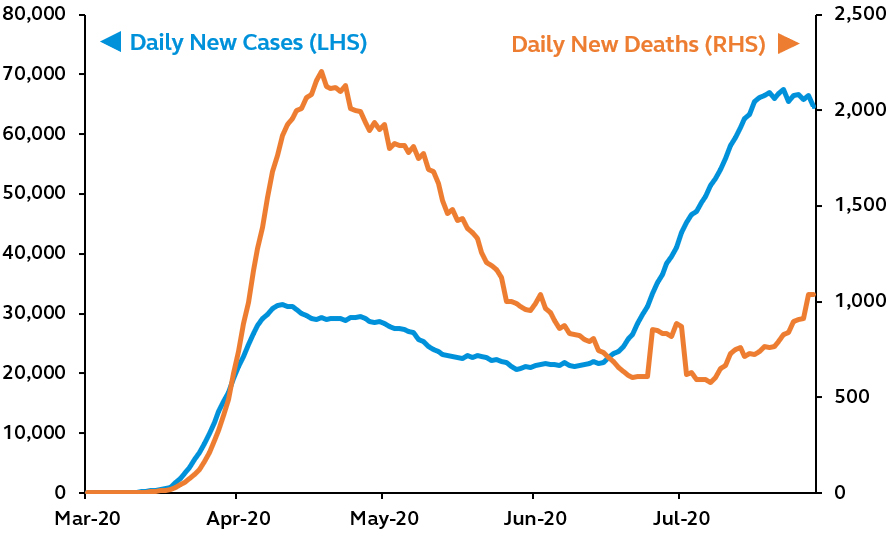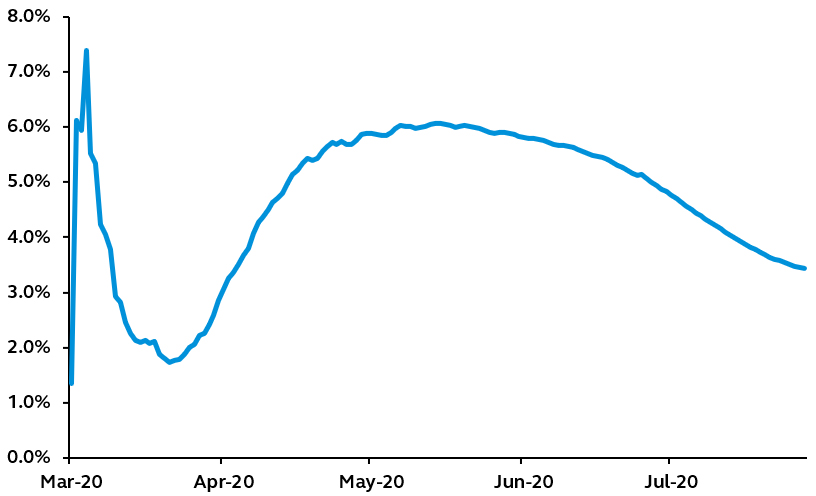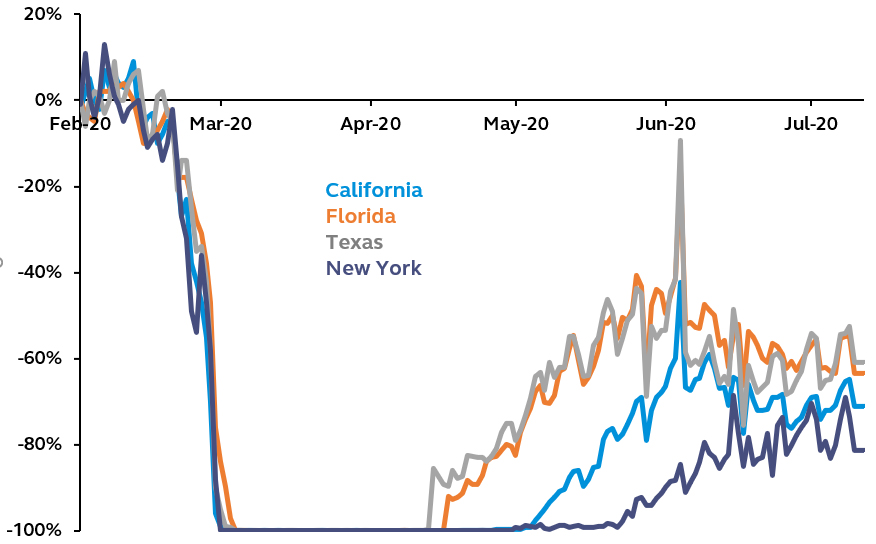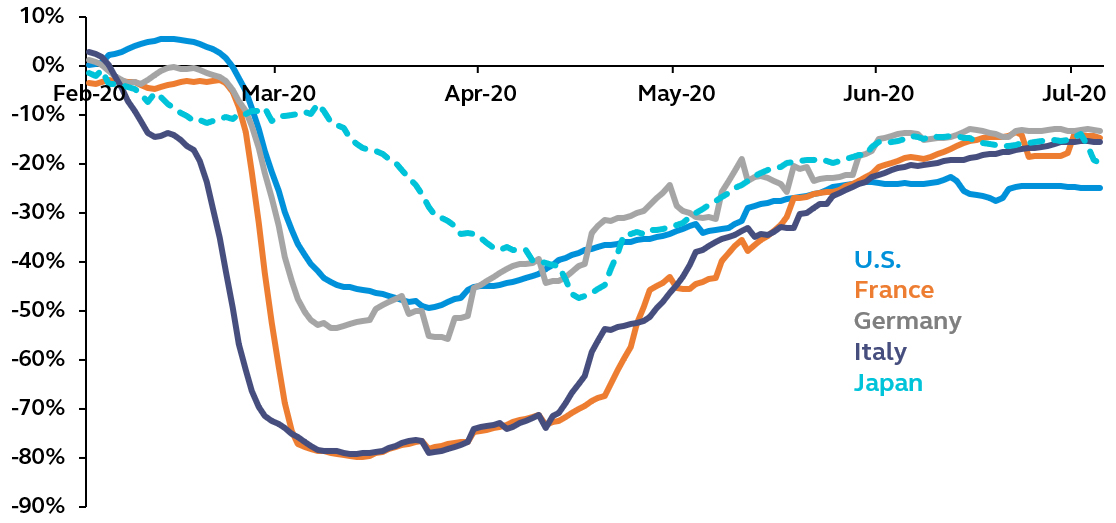Perhaps we should have stayed at home…
Escalating COVID-19 infection rates in the U.S. have forced a rollback of many economic opening measures, potentially uprooting the already fragile recovery in U.S. growth. Even in states which have so far avoided a virus resurgence, anxiety and caution are beginning to spread, weighing on activity. Although lockdowns may be localised, the consumer and business response may be national and, until the pandemic is brought under control, the macro outlook will remain beholden to the virus.
A closer look at the numbers
In Europe & developed Asia, aside from some local spikes, COVID-19 infection rates remain relatively low. By contrast, they have surged in the U.S., with daily new cases hitting 65,000 on average over the last two weeks, up from around 21,000 per day in early June.
Many people, and often those leading the charge for more lax social distancing measures, have argued that the spike in cases is simply the result of high testing volumes. However, the data do not support this claim: there has been a steady rise in the percentage of positive test rates in all the badly hit states.
U.S. Coronavirus Activity
7-Day Average, March 2020 – present

Source: Johns Hopkins University, Principal Global Investors. Data as of July 28, 2020.
Mortality Rate
Percent, March 2020 – present

Source: Johns Hopkins University, Principal Global Investors. Data as of July 28, 2020.
One encouraging development
Although fatalities have begun to follow cases higher, the mortality rate has been declining. This could be because the older and more vulnerable segment of the population are going to greater lengths to protect themselves, the average age of people now getting infected is younger. In addition, hospitals are better equipped to deal with the virus, both in terms of knowledge and treatment. Since mortality data are a lagging indicator, the number of deaths is likely to continue increasing. However, given these developments, it seems unlikely that death rates going forward will get close to the highs seen in mid-April.
Unfortunately, that will not be enough to spare the U.S. from further economic damage. As the daily cases grow, there is a risk that consumers and businesses begin to behave as if they are in a lockdown, even as the economy remains open.
The uphill struggle back to pre-COVID activity levels
Admittedly, traditional economic data have largely indicated that activity resumed in May and June as virus-related restrictions were lifted. U.S. retail sales increased 7.5% in June, while industrial production grew 5.4%. Surveys have also pointed to a pick-up in activity, with both the ISM manufacturing and non-manufacturing indices moving above the 50 threshold in June.
Yet, investors shouldn’t necessarily interpret this data as evidence of a strong sustainable recovery. After a disastrous April where activity essentially came to a halt, simple arithmetic implies that positive monthly growth numbers are inevitable. Economic activity still has a very long way to before it reaches its pre-COVID levels. Even impressive job gains in May and June only represent 34% of the 22.1 million jobs lost in the prior two months.
The sharp increase in COVID cases has made the uphill struggle that much harder
High frequency data related to restaurant bookings have flattened out in recent weeks, with the impact especially evident in states hardest hit by the virus, but also pronounced in some states where numbers have not surged, such as New York. In fairness, mobility data suggest the pick-up in economic activity has plateaued in many countries, including those that haven’t yet experienced a meaningful increase in virus cases. But notably, U.S. mobility data has plateaued at a lower level and is even showing very tentative signs of a renewed modest downward trend.
Unemployment may also be about to suffer its own second wave. Much of the recent job gains have been concentrated in retail, leisure and hospitality—sectors that involve a higher level of human contact and, unfortunately, also the ones that will be hurt the most by the surge in cases.
OpenTable Reservations: Seated Diners
Yoy percent change, February 2020 – present

Source: OpenTable, Principal Global Asset Allocation. Data as of July 28, 2020.
Change in Mobility
Percent, February 21, 2020 – present

Source: Google Mobility Reports, Principal Global Asset Allocation. Data is based on the 7-day moving avg. of retail & recreation, workplace & transit categories of Google’s Mobility Reports. Data as of July 25, 2020.
Policymakers can ease the burden
Concerns around rising virus cases and their impact on the labor market and activity will be further compounded if Congress cannot agree on a new fiscal stimulus package before summer recess. One of the key factors that enabled consumer spending and jobs to rebound so sharply in May and June was the $3tn in fiscal stimulus. With special unemployment benefits set to expire at the end of this week, the recovery is at stake.
There is no doubt that the Federal Reserve will do what it can to prop up the economy and markets. But with rates already so low, monetary policy is becoming less effective at stimulating the economy. Even Robert Kaplan, president of the Dallas Fed, has said that a wearing masks would be more a more effective economic policy than anything fiscal or monetary stimulus could do. Policymakers can soften a downturn, but ultimately, they do not have the power to prevent it.
Another winter of discontent?
As the winter approaches and the “standard” influenza season begins we must consider whether things get as bad as they were in March. Remember, many U.S. states chose to begin reopening while cases were flat despite reopening guidelines advising that each phase of reopening should start only after a two-week decline in cases. If there is a resurgence in the virus, policymakers may have less tolerance for outbreaks and be more heedful of reopening advice.
While a resurgence could imply a more prolonged economic hit, consider too that governments globally are likely to keep renewed restrictions as targeted and local as possible. As such, we wouldn’t expect a potential downturn to be as severe as it was March/April. Nationwide lockdowns would only emerge as a genuine consideration in the worst-case scenario, where cases continue to soar into the fall, when hospital capacity is becoming strained.
At the same time, investors should take encouragement from the fact that major economies in Europe and Asia have, broadly speaking, managed to break the link between the virus and mobility—improving economic activity levels without triggering a significant resurgence in the virus cases. Policy and behavioural changes, such as contact testing and tracing, mask-wearing and overall better hygiene practices, seem to have been effective at controlling COVID-19. A viable reopening path exists—providing the correct precautions are taken.
Investment considerations
Make no mistake, the coming months will prove testing. The U.S. recovery is likely to face challenging times—either from floundering consumer confidence, renewed lockdowns or a reversal of government fiscal support.
In this environment where the economic and financial risks are tightly intertwined with health risks, investors may want to shift to a more defensive stance within the U.S. Alternatively, other regions beckon. Much of Emerging Asia and Europe are faring better in controlling the virus, have fiscal policy still on their side, and valuations are more attractive. The tide is no longer going to lift all boats, so pick your vehicle wisely.
Get investment insights from industry leaders
Liked this wire? Hit the follow button below to get notified every time I post a wire. Not a Livewire Member? Sign up for free today to get inside access to investment ideas and strategies from Australia’s leading investors.

